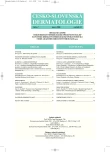Contact Dermatitis after Henna Tattooing
Authors:
R. Schmiedbergerová; M. Šebková; N. Vojáčková; J. Hercogová
Authors‘ workplace:
Dermatovenerologická klinika 2. LF UK a FN Na Bulovce
přednostka prof. MUDr. J. Hercogová, CSc.
Published in:
Čes-slov Derm, 83, 2008, No. 1, p. 25-29
Category:
Case Reports
Overview
Recently the temporary painted tattooing becomes very popular as a safe alternative to permanent tattooing. Most frequently vegetable dye henna is used. Allergic reactions to natural henna are very rare, however the number of published cases of contact allergies to henna used for temporary tattooing rises. Article describes 2 cases of henna tattooing leading to contact allergy in which the patch tests showed positive reaction to paraphenylendiamine added to tattoo dye to make the picture stable and more intensive.
Key words:
henna – paraphenylendiamine (PPD) – contact sensitivity
Sources
1. BALLARD, MS. Contact dermatitis after henna skin tattooing. J. R. Army Med Corps. 2006, 152, (4), p.242-3.
2. BIRNIE, A.J. Immediate hypersensitivity to paraphenylendiamine. Contact Dermatitis, 2007, 56, p. 240.
3. BOSCHNAKOW, A. Temporary tattooing with henna induces contact allergy to textile dyes. J.Dtsch Dermatol Ges, 2003, 1, (12), p-962-4.
4. CORRENTE, S. Temporary henna tatoo is unsafe in atopic children. Acta Paediatr, 2007, 96, (3), p. 469-71.
5. DASTYCHOVÁ, E. Kontaktní ekzém z přecitlivělosti na kosmetické přípravky. In Urbanček, S. a kol. Kontaktné alergény v pracovnom a životnom prostredí, Polygrafia Gutenberg, s. r. o., Banská Bystrica, 2006, s. 121-141.
6. EAGER, RP. Atopy to henna tattoos in children. Eur J Emerg Med, 2005, 12, (4), p. 189-90.
7. GULEN, F. Urticaria and angioneurotic edema due to the temporary henna tattoo. Minerva Pediatr, 2006, 58, (6), p. 583-5.
8. HABBAL, OA. In vitro antimicrobial activity of Lawsonia inermis Linn (henna). A pilot study on the Omani henna. Saudi Med J, 2005, 26, (1), p. 69-72.
9. CHUNG, W.H. Clinicopathologic features of skin reaction to temporary tattoos and analysis of possible causes. Arch Dermatol, 2002, 138, p. 88-92.
10. JIRÁSEK, L. Skupina ekzému. In: Šťáva, Z. a kol. Dermatovenerologie, Avicenum, Praha, 1977, s. 148-163.
11. KANG, IJ. Quantification of para-phenylendiamine and haevy metals in henna dye. Contact Dermatitis, 2006, 55, (1), p. 26-9.
12. KRAELING, ME. Absorption of lawson through human skin. Cutan Ocul Toxicol, 2007, 26, (1), p. 45-56.
13. MARKS, JG., ELSNER, P., DELEO, VA. Contact Occupational Dermatology, Mosby, 2002.
14. MIKHAEIL, BR. Antioxidant and immunomodulatory constituents of henna leaves. Z Naturforsch, 2004, 59, (7-8), p. 468-76.
15. THYSSEN, JP. Contact allergy epidemics and their controls. Contact Dermatitis, 2007, 36, p. 185-195.
16. URBANČEK, S. Alergény štandardnej série. In Urbanček, S. a kol. Kontaktné alergény v pracovnom a životnom prostredí, Polygrafia Gutenberg, s. r. o., Banská Bystrica, 2006, s. 41-79.
17. UTER, W. Is incident sensitization to p- phenylendiamine related to particular exposure patterns? Results of a questionnaire study. Contact Dermatitis, 2007, 56, p. 266-70.
18. VEYSEY, EC. Consort contact dermatitis to paraphenylendiamine, with unusual Clinical presentation of tumid plaques. Contact Dermatitis, 2007, 56, p. 366-367.
19. WHITE, JML. Intermitent exposure to low-concrentation paraphenylendiamine can be equivalent to single, higher dose exposure. Contact Dermatitis, 2007, 56, p. 262-263.
Labels
Dermatology & STDs Paediatric dermatology & STDsArticle was published in
Czech-Slovak Dermatology

2008 Issue 1
Most read in this issue
- Cutaneous Metastases
- Contact Dermatitis after Henna Tattooing
- In vitro Diagnostics of Allergic Contact Dermatitis – Examination of Peripheral Blood Mononuclear Cells of Nickel Allergic Patients by the Means of Lymphocyte Transformation Test and ELISA for Determination of Interleukin 5
- F. Goya: Family of Spanish King Charles IV from the View of Dermatologist and Ophthalmologist
